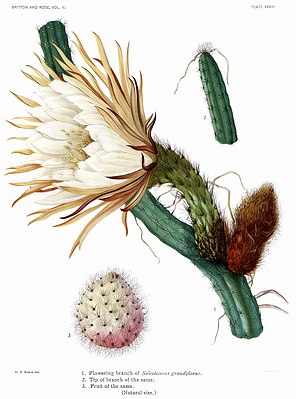Selenicereus grandiflorus
| Selenicereus grandiflorus | ||||||||||||
|---|---|---|---|---|---|---|---|---|---|---|---|---|

Selenicereus grandiflorus |
||||||||||||
| Systematics | ||||||||||||
|
||||||||||||
| Scientific name | ||||||||||||
| Selenicereus grandiflorus | ||||||||||||
| ( L. ) Britton & Rose |
Selenicereus grandiflorus is a species of plant in the genus Selenicereus from the cactus family(Cactaceae). Thespecific epithet grandiflorus is derived from the Latin words grandis for 'large' and -florus for '-blühend' and refers to the large flowers of the species. Common names are "Queen of the Night", "Reina de la Noche" and "Queen of." the Night ". The German Cactus Society as well as the Society of Austrian Cactus Friends and the Swiss Cactus Society voted Selenicereus grandiflorus 2009 "Cactus of the Year".
The Queen of the Night got its name because its specialty is that its flowers only bloom once a year and only for one night at a time. This is in many z. B. Botanical Gardens celebrated as a spectacular event.
description
Selenicereus grandiflorus grows straddling or climbing with shoots up to 5 meters long and 1 to 2.5 centimeters in diameter. There are four to eleven low ribs . The areoles on it are not raised or raised and without numerous hairs . The six to 18 whitish to brownish thorns arising from them are bristle-like or occasionally fine needle-like and piercing. They reach lengths of 0.45 to 1.5 centimeters and fall off later.
The fragrant flowers are up to 30 centimeters long and reach the same diameter. Their outer bracts are yellow to brownish and narrow, the inner ones are white and wider. The spherical to egg-shaped fruits are pink to magenta in color and 8 centimeters long.
Distribution, systematics and endangerment
Selenicereus grandiflorus is common in the southeastern United States , Mexico, and the Caribbean .
The first description as Cactus grandiflorus by Carl von Linné was published in 1753 in Species Plantarum . Nathaniel Lord Britton and Joseph Nelson Rose put the species in the genus Selenicereus in 1909 . A nomenclature synonym is Cereus grandiflorus (L.) Mill. (1768).
The following subspecies are distinguished:
- Selenicereus grandiflorus subsp. grandiflorus
- Selenicereus grandiflorus subsp. Lautneri Ralf Bauer
Selenicereus grandiflorus subsp. grandiflorus
The subspecies has four to six (rarely up to eight) ribs. It iswidespreadin the United States in the state of Florida , in the Mexican states of Tamaulipas and Veracruz , in the Bahamas , Cuba , in the Dominican Republic , Haiti , Jamaica , in Puerto Rico andin the low-lying areas ofthe Virgin Islands . Synonyms are Cereus jalapaensis Vaupel (1913), Cereus paradisiacus Vaupel (1913), Cereus roseanus Vaupel (1913), Cereus hallensis Weing. ex Borg (1937, nom. inval. ICBN -Article 32.1c) and Cereus hallensis Weing. ex Borg (1951, nom. invalid ICBN -Article 36.1).
Selenicereus grandiflorus subsp. lautneri
The first description of Selenicereus grandiflorus subsp. Lautneri by Ralf Bauer was published in 2003. The subspecies has nine to eleven ribs. It iswidespreadin the Mexican state of Oaxaca on the Pacific coast at low altitudes.
In the Red List of Threatened Species of the IUCN , the species is listed as " Least Concern (LC) ". H. listed as not endangered.
ingredients
There are several medically effective ingredients in the plant. The flowers of Selenicereus grandiflorus contain betacyans and about 1.5% flavonol glycosides . Eight glycated flavonoids were detected: Narcissin (0.05%), Cacticin (0.02%), rutoside , hyperoside , Kaempferitrin , Grandi Florin , isorhamnetin-3-O-β- (xylosyl) -Rutinosid and isorhamnetin-3-O -β- (galactosyl) rutinoside . The shoots appear to have the same spectrum of flavonoids. They also contain the biogenic amines tyramine (0.3% of dry matter), N-methyltyramine and hordenine (N, N-dimethyltyramine). Other ingredients are mucus, fat, wax and resinous glycosides.
proof
literature
- Edward F. Anderson : The Great Cactus Lexicon . Eugen Ulmer KG, Stuttgart 2005, ISBN 3-8001-4573-1 , p. 589 .
Individual evidence
- ↑ Urs Eggli, Leonard E. Newton: Etymological Dictionary of Succulent Plant Names . Springer, Berlin / Heidelberg 2010, ISBN 978-3-642-05597-3 , p. 98.
- ↑ The "Queen of the Night" is Cactus of the Year 2009. DKG - Deutsche Kakteen-Gesellschaft eV, accessed on December 20, 2018 .
- ↑ garden dictionary. Retrieved October 15, 2019 .
- ↑ The "Queen of the Night" in the Botanical Garden in Potsdam only unfolds its blossoms for a short time this evening. Retrieved October 15, 2019 .
- ↑ Carl von Linné: Species Plantarum . Volume 1, 1753, p. 467 ( online ).
- ^ Nathaniel Lord Britton, Joseph Nelson Rose: The Genus Cereus and its Allies in North America . In: Contributions from the United States National Herbarium . Volume 12, Number 10, 1909, p. 430 ( online ).
- ^ The Gardeners Dictionary . 8th edition 1768, without page numbers ( online ).
- ^ F. Vaupel: Directory of the new genera and species . In: Monthly for cactus science . Volume 23, 1913, number 2, p. 26 and number 6, p. 85.
- ^ F. Vaupel: Directory of the new genera and species . In: Monthly for cactus science . Volume 23, 1913, number 3, p. 37 and number 6, p. 87.
- ^ F. Vaupel: Directory of the new genera and species . In: Monthly for cactus science . Volume 23, 1913, number 2, p. 27 and number 6, p. 85.
- ↑ Ralf Bauer: A synopsis of the tribe Hylocereceeae F. Buxb. In: Cactaceae Systematics Initiatives . Number 17, 2003, p. 45.
- ↑ Selenicereus grandiflorus in the IUCN Red List of Threatened Species 2013.2. Posted by: Taylor, NP, Durán, R., Hernández, HM, Tapia, JL & Gómez-Hinostrosa, C., 2009. Retrieved January 8, 2014.
- ↑ Markus Berger: Selenicereus grandiflorus - a medicinal cactus . In: Cacti and other succulents . Volume 56, Number 11, 2005, pp. 289-293.
- ↑ EMEA / MRL / 601/99-FINAL Summary Report: Selenicereus grandiflorus . The European Agency for the Evaluation of Medicinal Products : Committee for Veterinary Medicinal Products, April 1999 ( PDF ).

